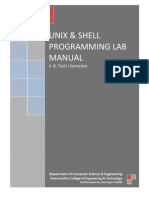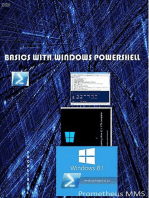Activty 2 Command Line Skills For Systems Administration Fundamentals
Activty 2 Command Line Skills For Systems Administration Fundamentals
Uploaded by
Melon TrophyCopyright:
Available Formats
Activty 2 Command Line Skills For Systems Administration Fundamentals
Activty 2 Command Line Skills For Systems Administration Fundamentals
Uploaded by
Melon TrophyOriginal Title
Copyright
Available Formats
Share this document
Did you find this document useful?
Is this content inappropriate?
Copyright:
Available Formats
Activty 2 Command Line Skills For Systems Administration Fundamentals
Activty 2 Command Line Skills For Systems Administration Fundamentals
Uploaded by
Melon TrophyCopyright:
Available Formats
Activity No.
2
Command Line Skills
Course Code: CPE231 Program:
Course Title: SYSTEM ADMINISTRATION FUNDAMENTALS Date Performed:
Section: Date Submitted:
Name: Instructor:
1. Objective(s):
This activity aims to execute basic commands using command line interface of Linux.
2. Intended Learning Outcomes (ILOs):
The students should be able to:
2.1 Demonstrate how to use commands to explore BASH features.
2.2 Demonstrate how to use commands to display the values of Shell variables.
2.3 Demonstrate how to use quoting in Bash shells.
3. Discussion :
<create a discussion about Shell, Bash Shell, Linux Commands, Arguments and Options, History,
Different Command Types, Shell Variables and Quoting >
4. Resources:
Personal Computer with installed Virtual Box
Ubuntu Server or Desktop virtual machine
5. Procedure:
1. Login using your username and password.
2. Use terminal emulator application (if you are using desktop version)
3. Execute the following commands. Copy a screenshot as output after you execute the given command.
Create a brief explanation of the command.
Command Screenshot Explanation
1. ls -l
2. ls -l ./Documents
3. whoami
4. Uname
5. pwd
6. echo Hi
7. history
8. history 5
9. !9
10. echo Hello
Student
11. echo $HISTSIZE
12. echo $PATH
13. which date
14. type cd
15. type ls
16. alias
17. type vi
18. cd /bin
19. type vlc
20. cd
21. echo Today is
`date`
22. echo Today is $
(date)
23. echo This is the
command '`date`'
24. echo This is the
command
\`date\`
25. echo This is the
command
"`date`"
26. echo D*
27. echo "D*"
28. echo Hello; echo
Linux; echo
Student
29. false; echo Not;
echo Conditional
30. echo Start &&
echo Going &&
echo Gone
31. echo Success
&& false &&
echo Bye
32. false || echo Fail
Or
33. true || echo
Nothing to see
here
34. printenv
35. printenv TERM
36. echo $TERM
37. env
7. Supplementary Activity:
Copy screen shot(s) of the following tasks:
1. An alias can be used to map longer commands to shorter key sequences. Use an alias to
represent a very long command.
2. Create a new directory in the Documents directory. Rename the directory as CPE_231_(lastname).
Create a new file inside the CPE_231_(lastname) directory. Rename the file as
sample1_lastname.txt. Display the content of the CPE_231_(lastname) directory by executing one
line of command only.
3. Execute a command to display the working shell.
4. Shell variables, called environment variables, have the string data type and typically are named
with capital letters and the _ (underline) character. Names are case sensitive. The env command
will list all the environment variables. The printenv command will list all or will list only the names
on its command line. List all environment variables. Which start with P?
__________________________________
7. Problem Analysis:
1. Execute ls $HOME. Now execute ls $HOME/.[a-z]* . Explain the difference of the two commands.
2. Differentiate internal commands from external commands.
3. To change an existing environment variable in the current terminal session, export DOG="hi there"
Try it. What command would print the value of DOG? _____________________________
8. Conclusion
8. Assessment (Rubric for Laboratory Performance):
You might also like
- Activity 4 Working With Files and DirectoriesDocument4 pagesActivity 4 Working With Files and DirectoriesMelon TrophyNo ratings yet
- CSE325 OS Laboratory ManualDocument36 pagesCSE325 OS Laboratory ManualKanna ChowdaryNo ratings yet
- OS Lab Manual PPPDocument41 pagesOS Lab Manual PPPvidya maliNo ratings yet
- Lab Manual CSE105Document40 pagesLab Manual CSE105sameer1645khanNo ratings yet
- S.No Page No.: IndexDocument56 pagesS.No Page No.: Indexjessk26No ratings yet
- OS LabsDocument63 pagesOS Labsroman naeemNo ratings yet
- IT7343 Module9 Lab9 LWatts25Document14 pagesIT7343 Module9 Lab9 LWatts25Lorenzo WattsNo ratings yet
- Unix Lab ManualDocument56 pagesUnix Lab ManualSRINIVASA RAO GANTANo ratings yet
- Experiment No. - 8 - Understanding The Basics of Shell Programming 1. Objective(s)Document8 pagesExperiment No. - 8 - Understanding The Basics of Shell Programming 1. Objective(s)Carlo BajaNo ratings yet
- Os LabDocument63 pagesOs LabsuriyakrishnanNo ratings yet
- Unix Lab ManualDocument56 pagesUnix Lab Manualjhonykrishna1233No ratings yet
- Lab5 3 1Document3 pagesLab5 3 1Byron FloreanoNo ratings yet
- System Administration FundamentalsDocument3 pagesSystem Administration FundamentalsMelon TrophyNo ratings yet
- OSlab Asgn2 Shell Design 2023 Part 1 Part 2Document6 pagesOSlab Asgn2 Shell Design 2023 Part 1 Part 2xahage9739No ratings yet
- Lab Assignment 5 PDFDocument36 pagesLab Assignment 5 PDFAnkit SrivastavaNo ratings yet
- Activity 5 Archiving and CompressionDocument3 pagesActivity 5 Archiving and CompressionMelon TrophyNo ratings yet
- Sahil Os (Ex-6 10) FinalDocument32 pagesSahil Os (Ex-6 10) Finalprajapatiurva082No ratings yet
- Os Lab Manual - 2024Document79 pagesOs Lab Manual - 2024vvswagatmishraNo ratings yet
- Uinx Shell ScirptDocument37 pagesUinx Shell Scirptsweety00jmNo ratings yet
- Cs6413-Os Lab Manual-Backup 2 NewDocument113 pagesCs6413-Os Lab Manual-Backup 2 NewjegadeepaNo ratings yet
- Unix & Shell Programming Lab ManualDocument49 pagesUnix & Shell Programming Lab Manualavinaashch@gmail.com100% (3)
- UNIX Shell ScriptingDocument39 pagesUNIX Shell ScriptingAvijit RoyNo ratings yet
- Os ManualDocument43 pagesOs Manualapi-321234099No ratings yet
- USP Lab Manual PDFDocument41 pagesUSP Lab Manual PDFsrinuNo ratings yet
- Lab 3 To 5Document12 pagesLab 3 To 5Aliza KhanNo ratings yet
- Shell ScriptingDocument23 pagesShell Scripting96d21065af6669No ratings yet
- Os Lab Manual-1Document65 pagesOs Lab Manual-1diranj0% (1)
- Os Lab ManualDocument83 pagesOs Lab Manual12 ALAN B CSE student100% (1)
- Unix Lab Manual For JNTU KDocument46 pagesUnix Lab Manual For JNTU Ksrikanth52460% (5)
- Bharath ItrecordDocument30 pagesBharath Itrecordbharathraj.drm12No ratings yet
- All Lab AssignmentDocument8 pagesAll Lab AssignmentKumar ShresthNo ratings yet
- Micro Project OS - MergedDocument11 pagesMicro Project OS - Mergedsayedshaad02No ratings yet
- Prac UnixDocument14 pagesPrac UnixNick RivieraNo ratings yet
- System and Network AdministrationDocument46 pagesSystem and Network AdministrationJeffreyson Violango PascoNo ratings yet
- Unit+3 LinuxDocument91 pagesUnit+3 LinuxyawenNo ratings yet
- UNIX Question Bank - FinalDocument6 pagesUNIX Question Bank - FinalramalalliNo ratings yet
- Os Labmanual BcaivDocument21 pagesOs Labmanual BcaivRahul JoshiNo ratings yet
- Operating System (22516) : "Implementing Directory Management Using Shell Script"Document8 pagesOperating System (22516) : "Implementing Directory Management Using Shell Script"2277vaishnavi yadavNo ratings yet
- Ge 2155 FullDocument81 pagesGe 2155 Fullvenkateshs_erNo ratings yet
- Unix Programming and Compiler DesignDocument68 pagesUnix Programming and Compiler DesignRaghu GowdaNo ratings yet
- OS Lab Manual - Student Copy 121Document99 pagesOS Lab Manual - Student Copy 121gauthamNo ratings yet
- Os Record - s23 and s18Document62 pagesOs Record - s23 and s18AFRID. SKNo ratings yet
- Assign 3Document2 pagesAssign 3scott.work96No ratings yet
- OSlab File PDFDocument46 pagesOSlab File PDFPrateek PalNo ratings yet
- N.balaji OS RecordDocument71 pagesN.balaji OS Recordbalaji baluNo ratings yet
- UNIX Shell Programming Interview Questions You'll Most Likely Be AskedFrom EverandUNIX Shell Programming Interview Questions You'll Most Likely Be AskedNo ratings yet
- UNIX Shell Scripting Interview Questions, Answers, and Explanations: UNIX Shell Certification ReviewFrom EverandUNIX Shell Scripting Interview Questions, Answers, and Explanations: UNIX Shell Certification ReviewRating: 4.5 out of 5 stars4.5/5 (4)
- Python Advanced Programming: The Guide to Learn Python Programming. Reference with Exercises and Samples About Dynamical Programming, Multithreading, Multiprocessing, Debugging, Testing and MoreFrom EverandPython Advanced Programming: The Guide to Learn Python Programming. Reference with Exercises and Samples About Dynamical Programming, Multithreading, Multiprocessing, Debugging, Testing and MoreNo ratings yet
- Learning Linux Shell Scripting: Unleash the power of shell scripts to solve real-world problems by breaking through the practice of writing tedious codeFrom EverandLearning Linux Shell Scripting: Unleash the power of shell scripts to solve real-world problems by breaking through the practice of writing tedious codeRating: 2.5 out of 5 stars2.5/5 (2)
- Command Line Fundamentals: Learn to use the Unix command-line tools and Bash shell scriptingFrom EverandCommand Line Fundamentals: Learn to use the Unix command-line tools and Bash shell scriptingNo ratings yet
- 1961 Plymouth Service Manual SupplementDocument149 pages1961 Plymouth Service Manual SupplementJeff Droll100% (2)
- Annx-1 Colly - 30-03-2015Document320 pagesAnnx-1 Colly - 30-03-2015Neeraj JhaNo ratings yet
- DPX VOl 21 4.7aDocument3 pagesDPX VOl 21 4.7aserfiarNo ratings yet
- Application of Information and Technology in Supply Chain Management of Fruits and Vegetables - A Brief OverviewDocument7 pagesApplication of Information and Technology in Supply Chain Management of Fruits and Vegetables - A Brief OverviewInternational Journal of Innovative Science and Research TechnologyNo ratings yet
- Freight Incentives Ease of Doing BusinessDocument58 pagesFreight Incentives Ease of Doing Businessjeya chandranNo ratings yet
- Important Medicinal and Aromatic Plants in South East Europe in Relation With Their Medicinal and Other Industrial Utilization Republic of MacedoniaDocument41 pagesImportant Medicinal and Aromatic Plants in South East Europe in Relation With Their Medicinal and Other Industrial Utilization Republic of MacedoniaOana Sidor100% (1)
- HP - Strong Buy: HP Lowers The BarDocument5 pagesHP - Strong Buy: HP Lowers The BarChetan AgarwalNo ratings yet
- Healthcare Waste Management Evaluation ToolDocument3 pagesHealthcare Waste Management Evaluation ToolMae Sheena Picardal MontallanaNo ratings yet
- Forensic Analysis of A Windows 2000 Server Operating System: Joshua Young CS585F - Fall 2002Document63 pagesForensic Analysis of A Windows 2000 Server Operating System: Joshua Young CS585F - Fall 2002Khan BahiNo ratings yet
- Fungal Biocontrol Agents of Weeds: Harry C. Evans, Mike P. Greaves and Alan K. WatsonDocument0 pagesFungal Biocontrol Agents of Weeds: Harry C. Evans, Mike P. Greaves and Alan K. WatsonSyed Ali Akbar BokhariNo ratings yet
- Azure Interview Questions and Answers: 4. What Is Azure Virtual Machine?Document7 pagesAzure Interview Questions and Answers: 4. What Is Azure Virtual Machine?hanuman challisaNo ratings yet
- Lean Startup DissertationDocument4 pagesLean Startup DissertationDoMyPaperForMoneyUK100% (1)
- DS WH Totalys-SlidePrep BR ENDocument2 pagesDS WH Totalys-SlidePrep BR ENDaniela ReyesNo ratings yet
- Business Comm Handout 3Document13 pagesBusiness Comm Handout 3Amor Jude Thadeus SorianoNo ratings yet
- Foundation MCQ 2012Document337 pagesFoundation MCQ 2012shivam kumarNo ratings yet
- SPE 210289 MS (Pluspetrol)Document13 pagesSPE 210289 MS (Pluspetrol)Alfonso RamosNo ratings yet
- Mathematics of Insurance (DR Nada)Document5 pagesMathematics of Insurance (DR Nada)Star LibraryNo ratings yet
- EXTRAJUDICIAL SETTLEMENT W. WAIVER OF RIGHTS Onofre PaguiaDocument4 pagesEXTRAJUDICIAL SETTLEMENT W. WAIVER OF RIGHTS Onofre PaguiaJorge M. GarciaNo ratings yet
- D17090GC31 sg2Document392 pagesD17090GC31 sg2Mahadev NaiknavreNo ratings yet
- New Trinitas in A NutshellDocument29 pagesNew Trinitas in A Nutshellgorot1No ratings yet
- Gard+Guidance+on+Maritime+Claims FinalDocument594 pagesGard+Guidance+on+Maritime+Claims FinalAlonso Olaya RuizNo ratings yet
- Aws B2.1/B2.1M-BMG:2014Document73 pagesAws B2.1/B2.1M-BMG:2014Baguz SaputraNo ratings yet
- Challenges of Performance AppraisalDocument7 pagesChallenges of Performance AppraisalPoulamiNo ratings yet
- Perspective Grid - Manual (EN - 03!11!2009)Document32 pagesPerspective Grid - Manual (EN - 03!11!2009)Alin DemetrescuNo ratings yet
- Sonographer's Job Market in OntarioDocument7 pagesSonographer's Job Market in OntarioSyedKashifAliNo ratings yet
- Fabm 1-PTDocument12 pagesFabm 1-PTMaxene YbañezNo ratings yet
- dr135 mk2Document60 pagesdr135 mk2zaenal abidinNo ratings yet
- Polly's Pet ProductsDocument7 pagesPolly's Pet Productsseles23734No ratings yet
- My Personal Mission Statment - Always UpdateDocument8 pagesMy Personal Mission Statment - Always UpdateChristian Dominic MarayagNo ratings yet
- Army Vaccination Centres 2021-08-27Document2 pagesArmy Vaccination Centres 2021-08-27Adaderana OnlineNo ratings yet

























































































